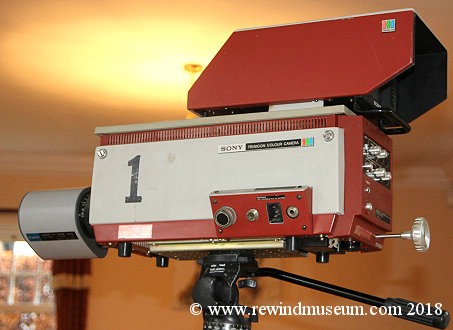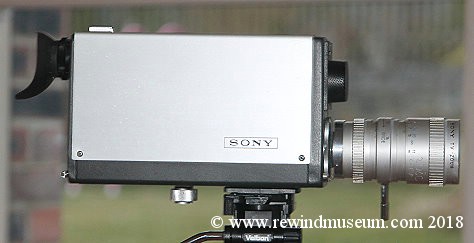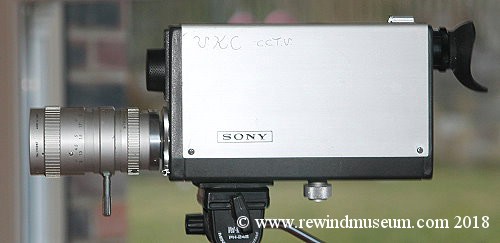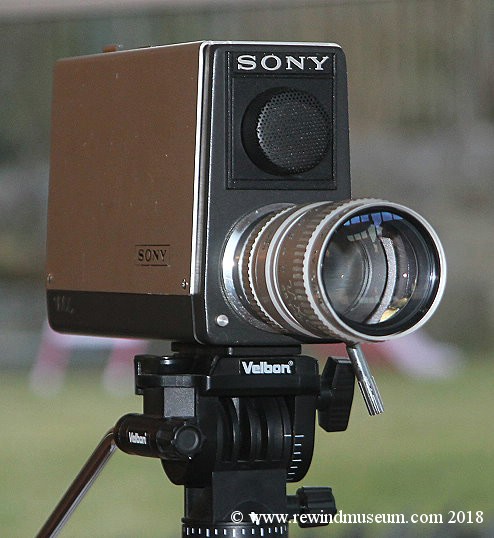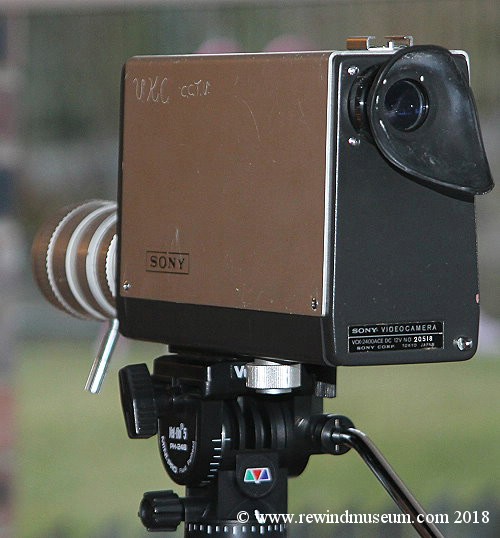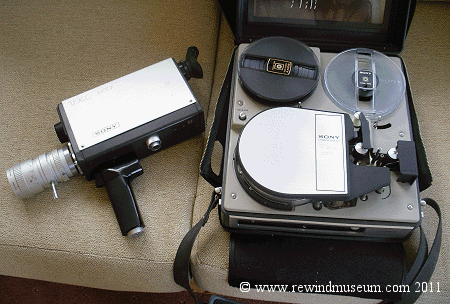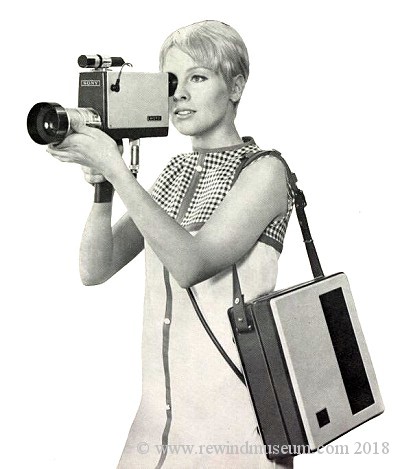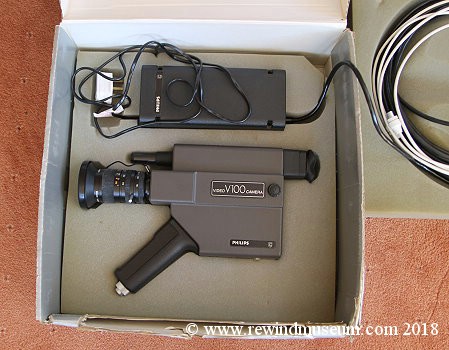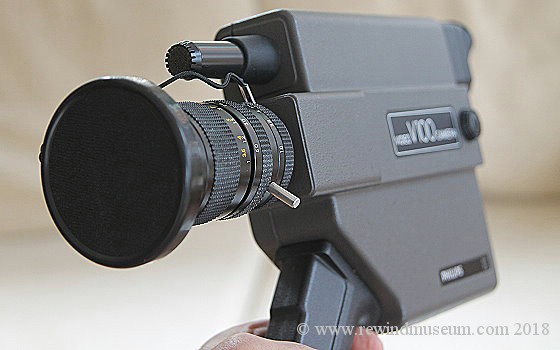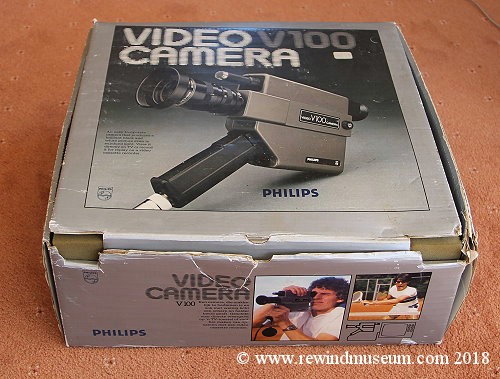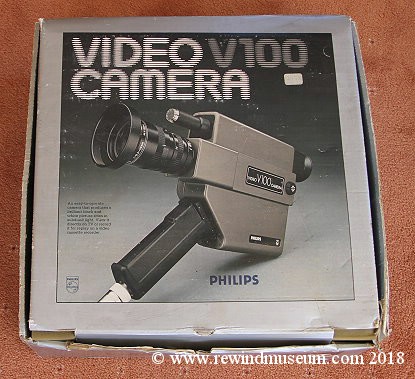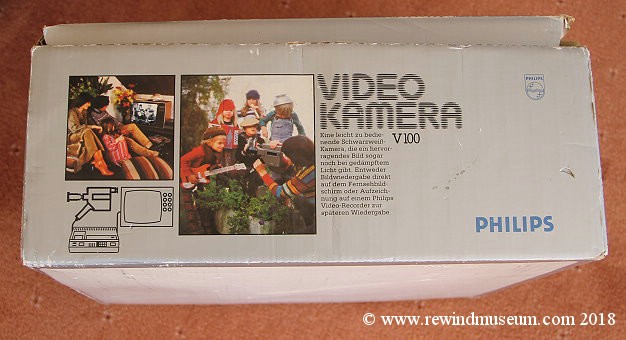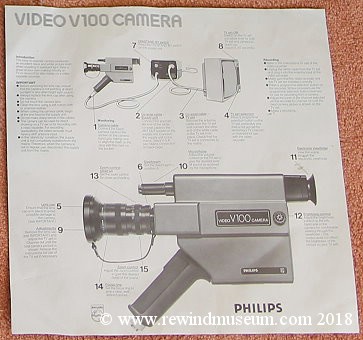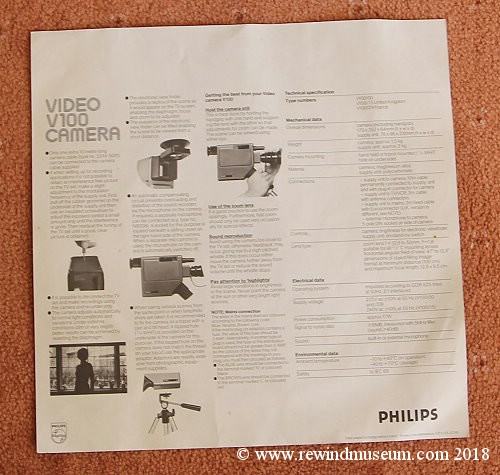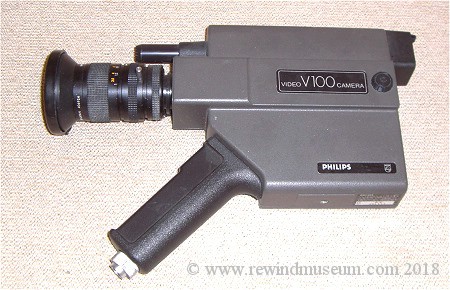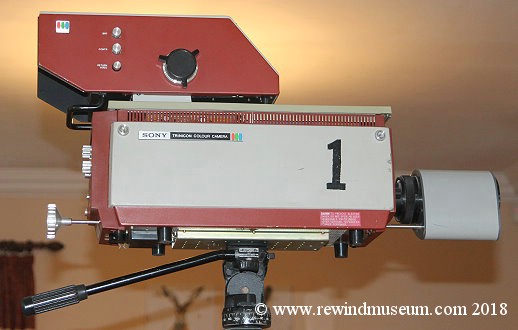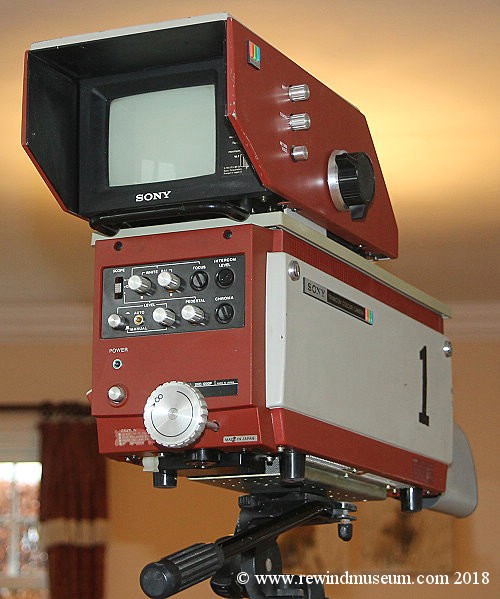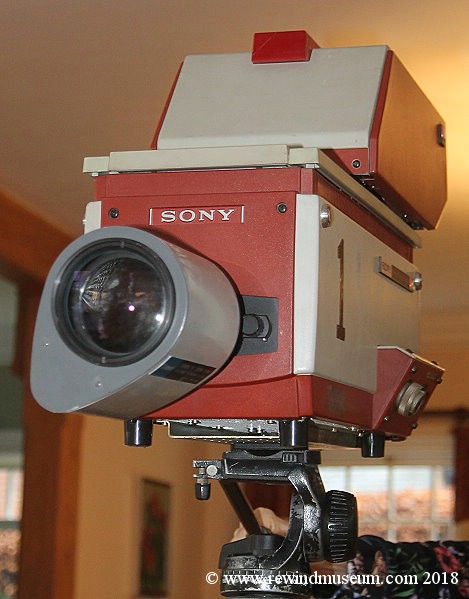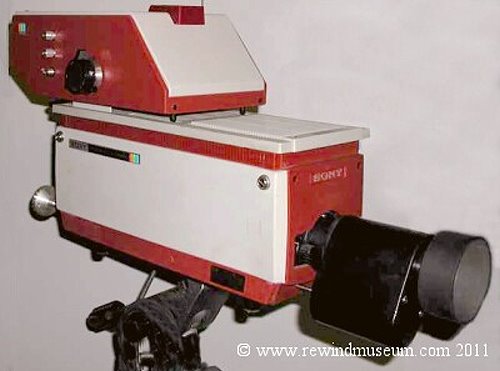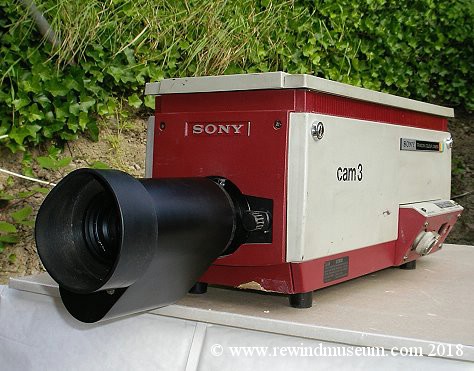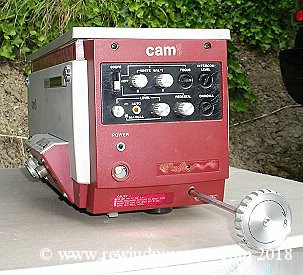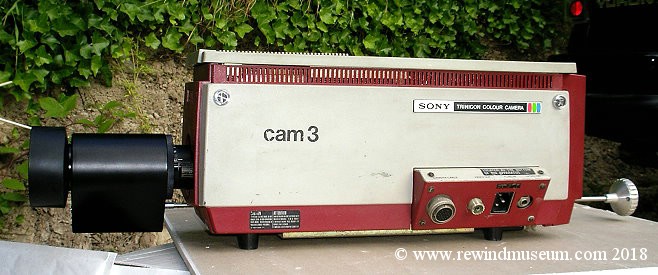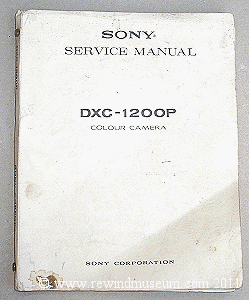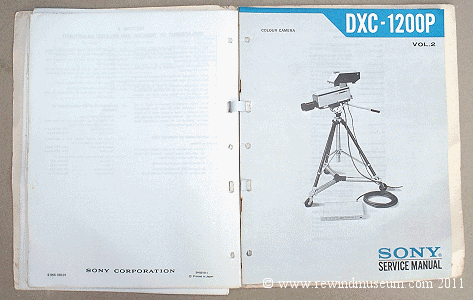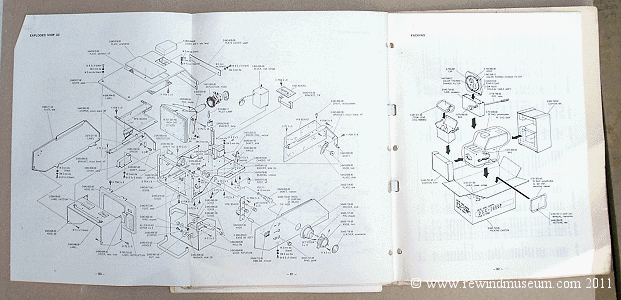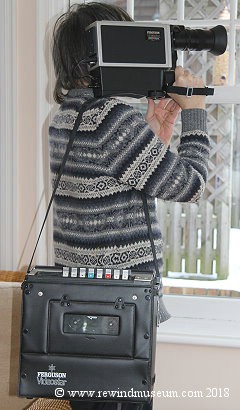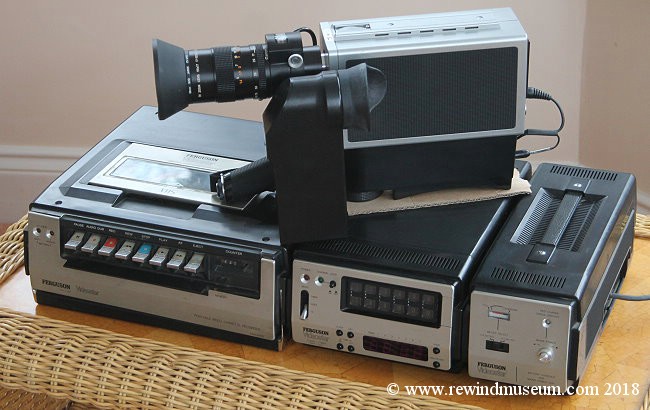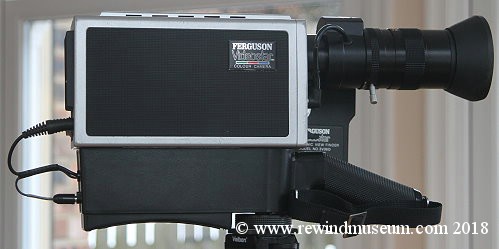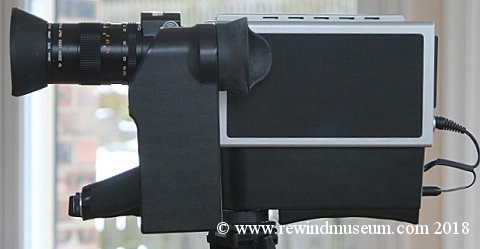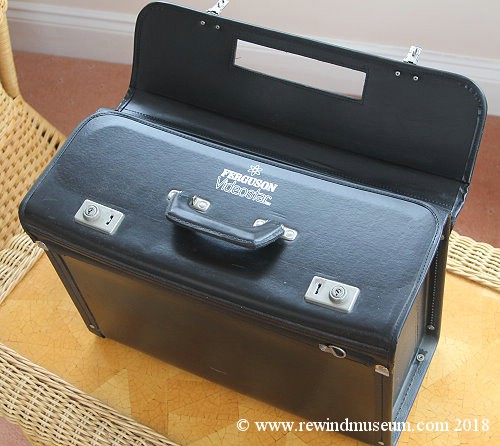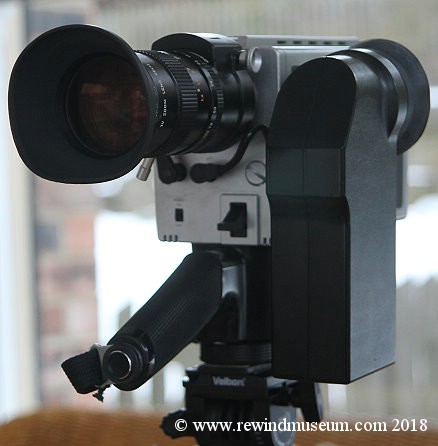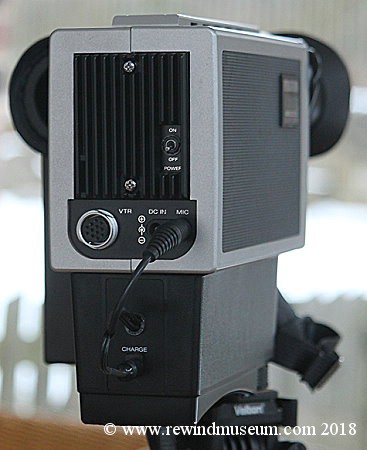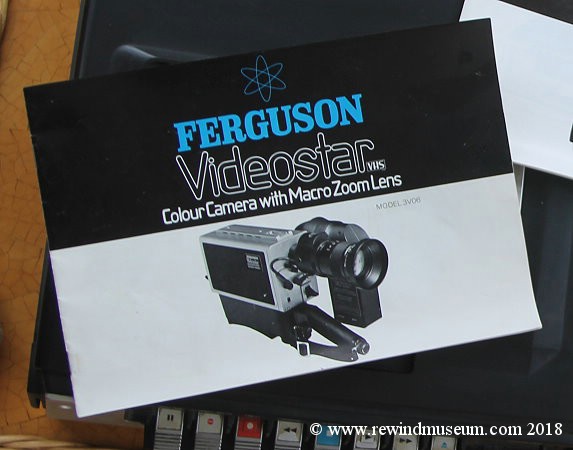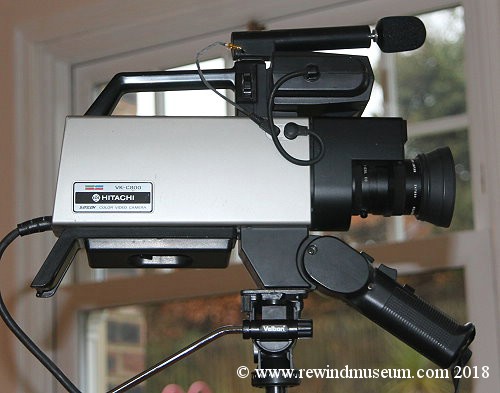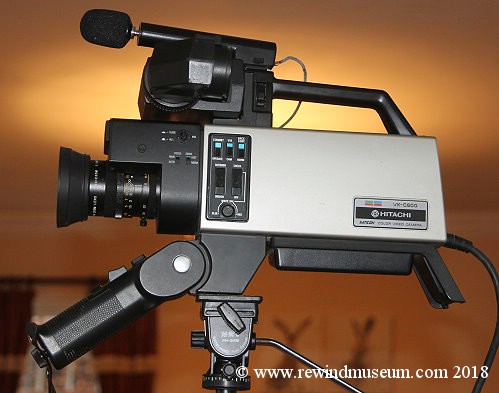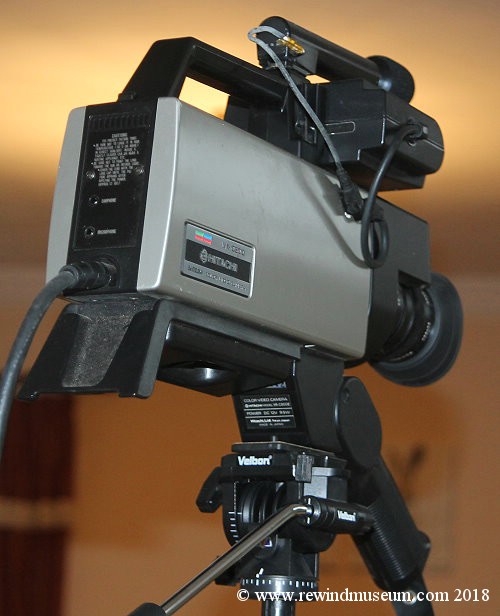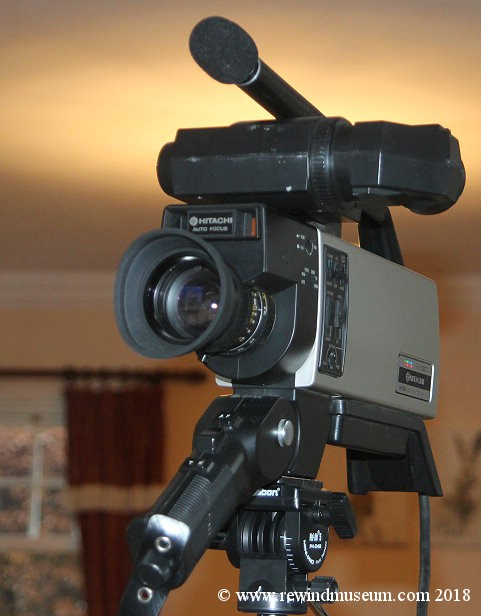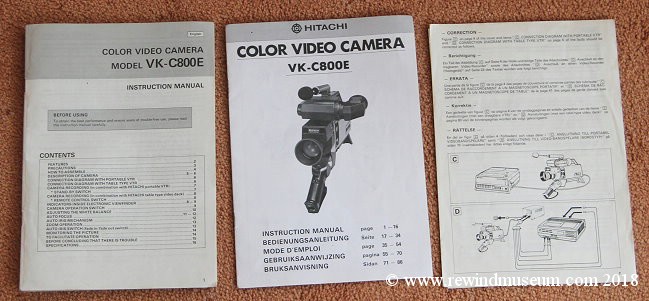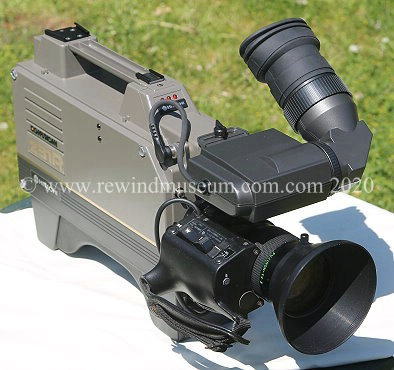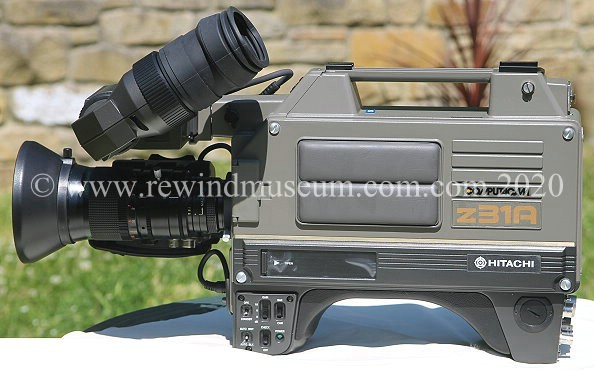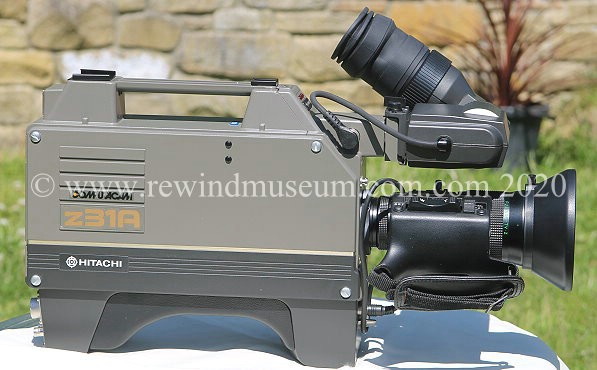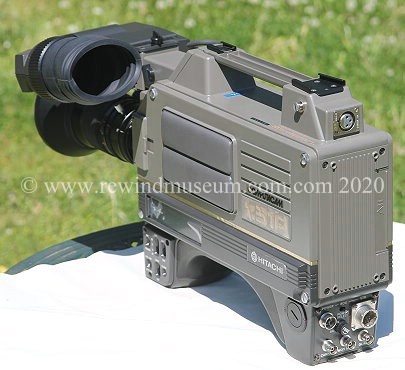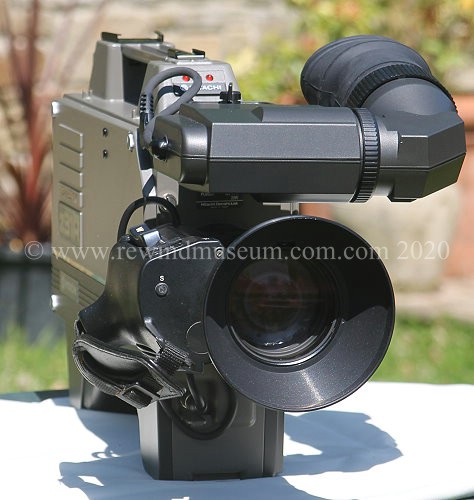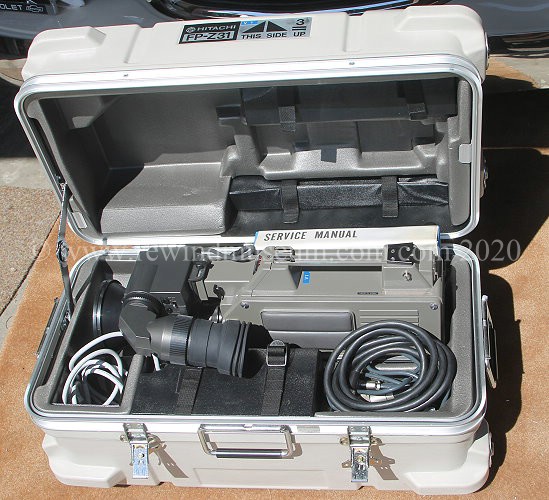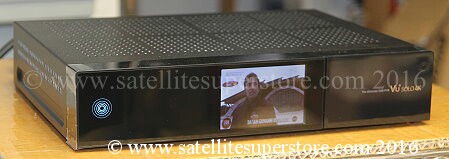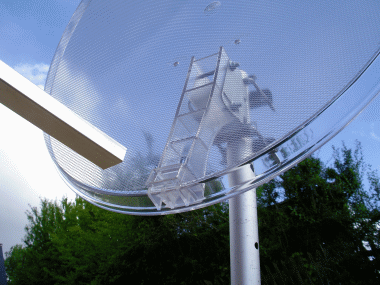1965. The Sony CVC-2000. 1st domestic video camera
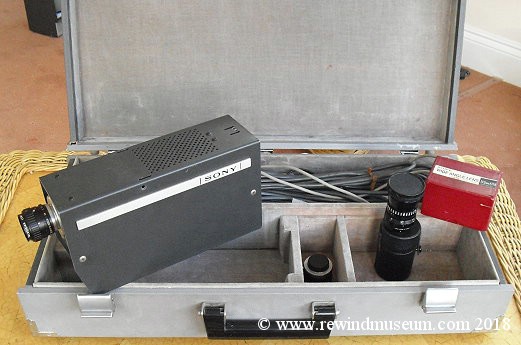
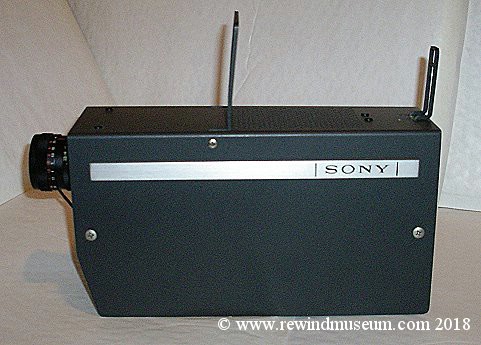
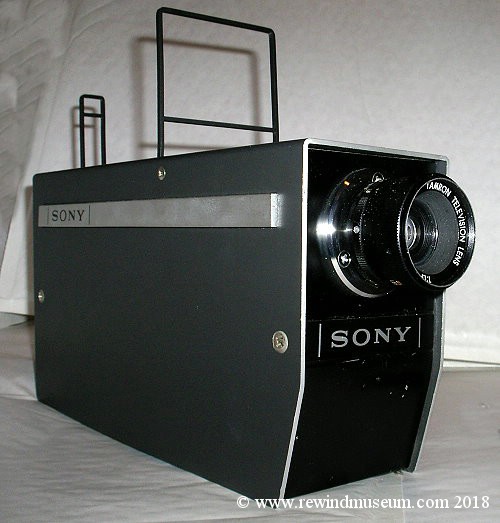
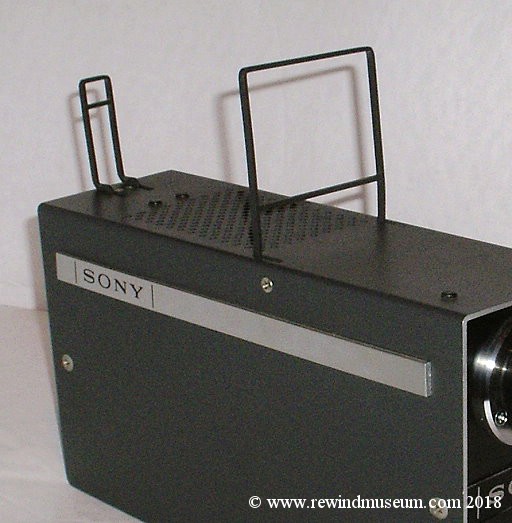
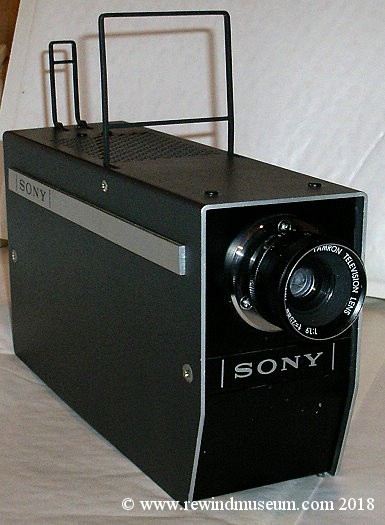
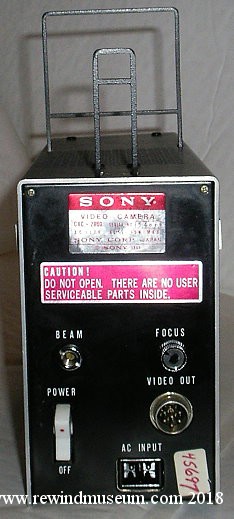
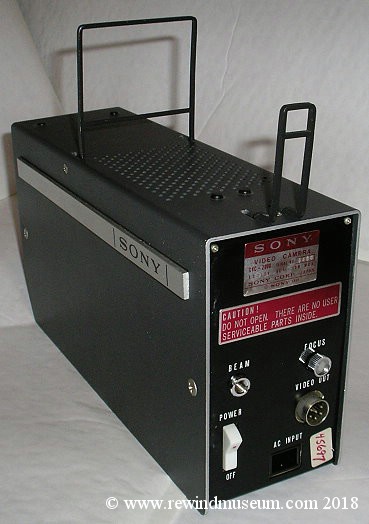 1965. VCC-2000 camera kit and monitor.
1965. VCC-2000 camera kit and monitor.
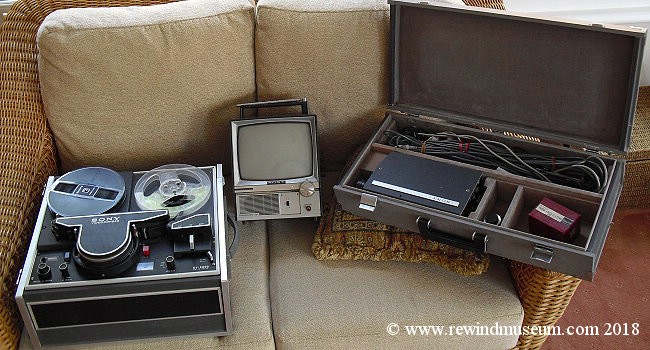
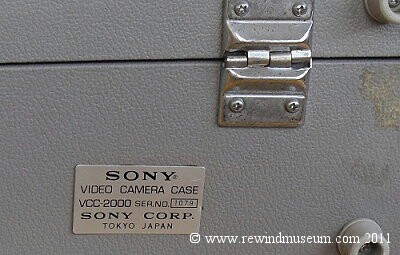
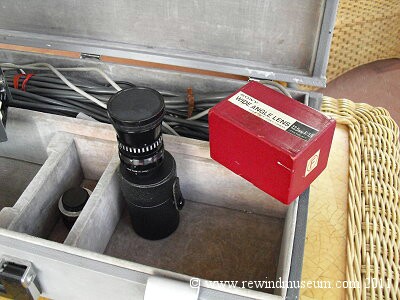
This was the first ever domestic video camera and it partnered the first ever domestic video tape recorder
(reel to reel), the
CV-2000. It is therefore a very important museum exhibit. There is no
viewfinder, no
mini CRT monitor, not even an optical viewfinder. There is, however, a couple of wire squares that have to
be lined up rather like cross wires. In the satellite industry, not using a proper meter for location, just
using a compass or the sun, shadows and time of day is often called "direct reckoning". If we were to call
these sights, "pointing by direct reckoning", we would not be far wrong! It is likely that the "parallax
errors" with this type of picture framing would be quite high but may be reduced with plenty of practice.
In the pictures above you can see a cvc-2000 camera, which is part of the complete vcc-2000 camera kit
and includes extra lenses and connection leads and in a carry case. Also shown is the VTR and TV. Of all
of the cameras in the museum, this one and the
Ampex CC-452, also for 1965 are the most
important as far as their place in the history of video recording is concerned.
Update Feb. 2023. Sony CVC-100 video camera.
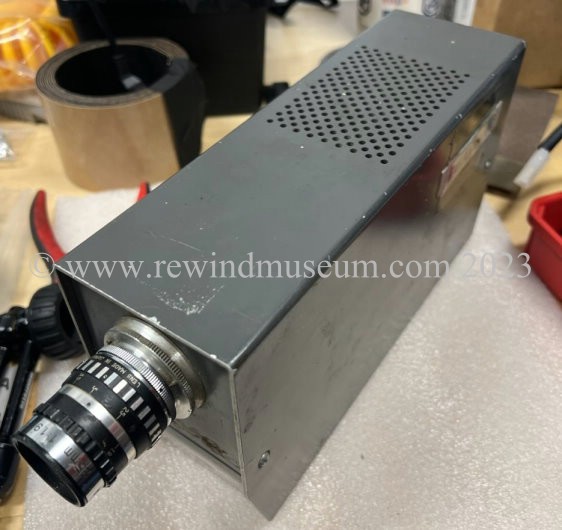
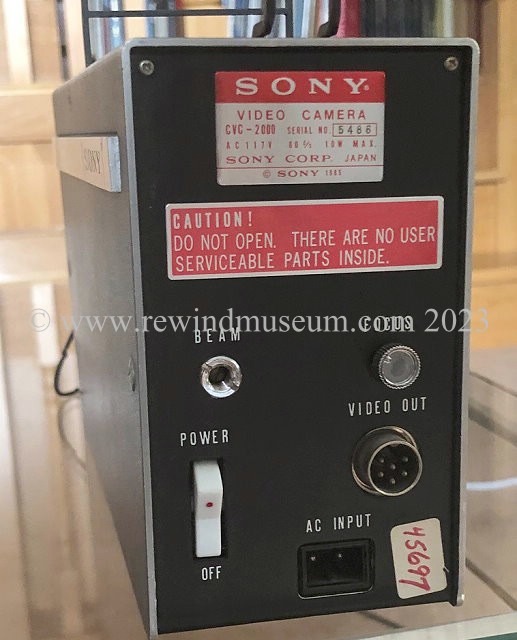
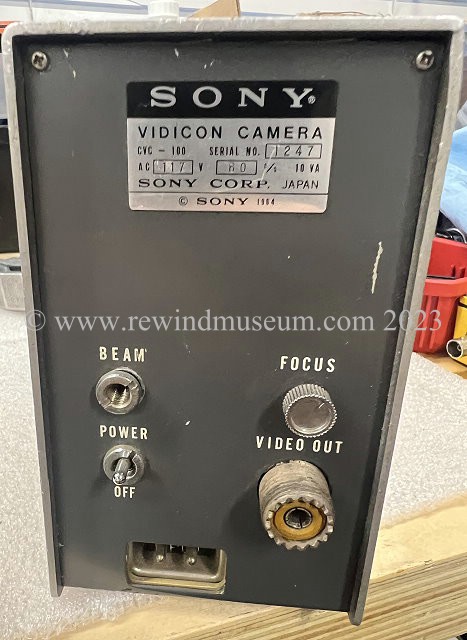
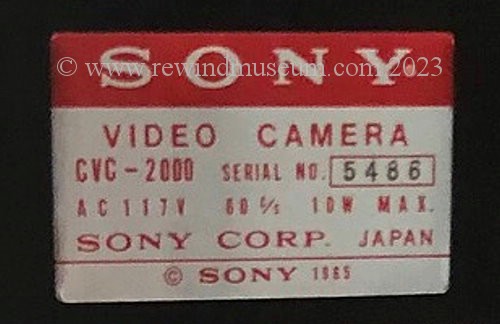
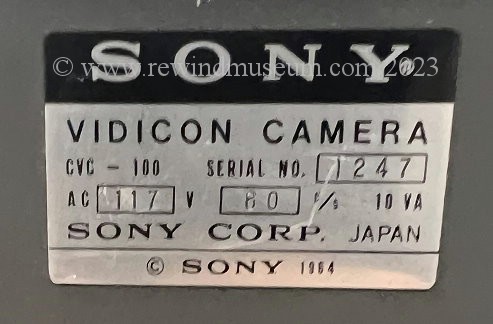
The CV-2000 camera kit above came into the possession of the museum in August 2010 but in February 2023 we
received an interesting email. It came from Canada about a Sony CVC-100 camera. Looking at the 2 pictures
provided you can see it is the same camera. Same case, same vent on the top, same layout of sockets
and switches on the back. The lens is different but this is interchangeable anyway. Differences?
No optical sights on the top. The toggle switch on the back is a different type. The output
connector is different. The power input socket is different both in type and position. Otherwise it
is the same camera. Now the really interesting part of this story is the date on the CVC-100 is 1964.
That means Sony produced this camera in 1964, 1 year earlier than is widely reported. There is
little known about the CV-100. Was it designed for the Canadian market? Without optical sights
could it have been for surveillance use? We may never know. The 1964 CVC-100 has a serial number
of 1247 and the 1965 CVC2000 has a serial number of 5468. It is important new information as
this was the very start of domestic video and we now know this camera was manufactured
by Sony as early as 1964.

1965. The Ampex CC-452 studio TV camera.
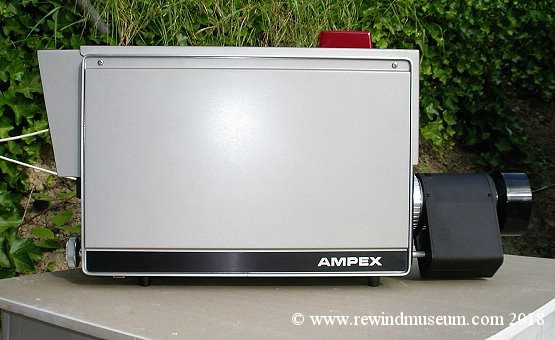
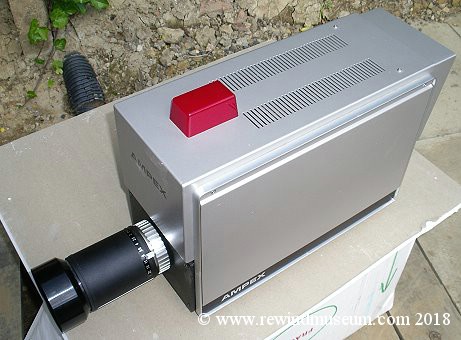
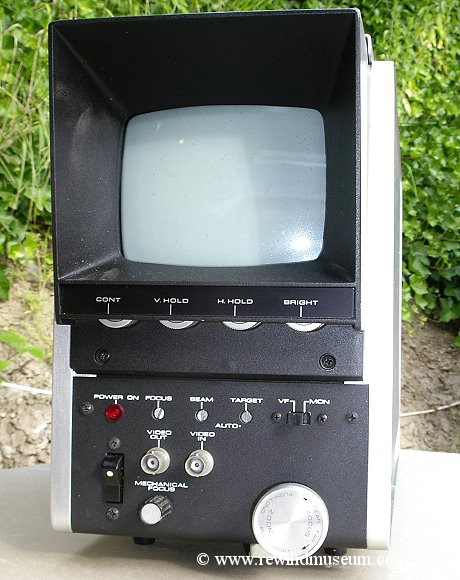
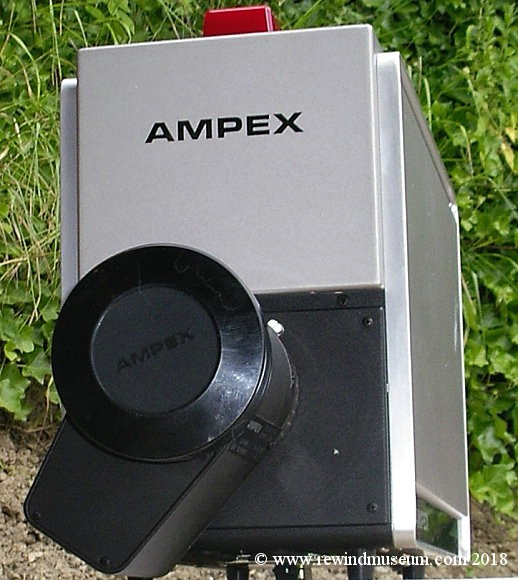
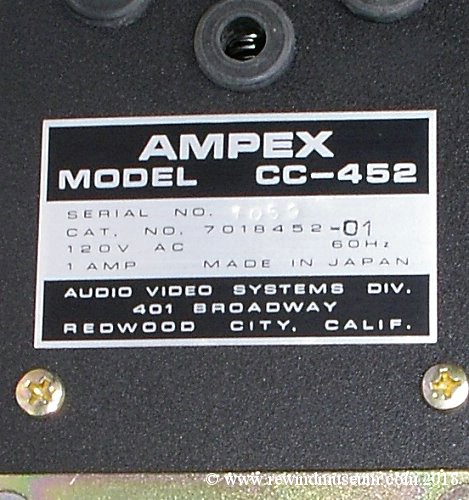
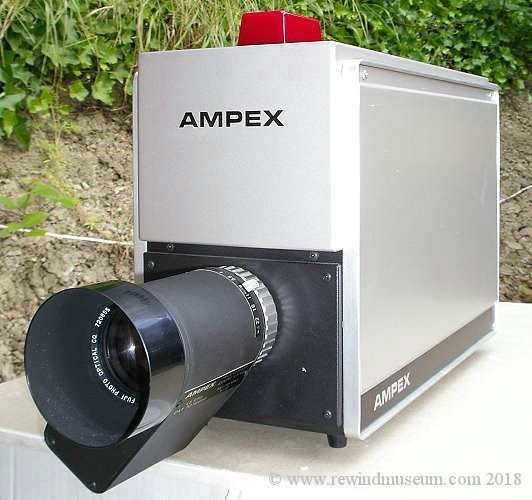
This camera has been in the museum since 2006. It is probably one of the two most important cameras in the museum.
This camera and the
Sony CVC-2000 above are very valued exhibits due to their
historic place in video history. It is
very similar and only two years after the camera packaged with the Ampex
Signature V system which was the worlds
first domestic video recording system. This studio camera was introduced 2 years later. Until 1965, video recorders
used heavy 2-inch video tape but here Ampex introduced the first 1-inch tape recorder, the
Ampex VR 5005 which is
also in the museum. Indeed it is highly likely this camera would have been used with the Ampex VR 5005 recorder.
These were professional products but the same year (1965) Sony introduced the first 1/2-inch domestic video recorder,
the
Sony 2000D and that was used with the CVC-2000 camera above. Ampex was founded in 1944 and incorporated
in Califirnia in 1946. In 1956 they introduce their first reel to reel video tape recorder - the VR 1000. This was a
quadruplex VTR. It was the worlds first production video tape recorder. Ampex are still in business today (2018).

1960s. The Shibaden HV-40SK camera
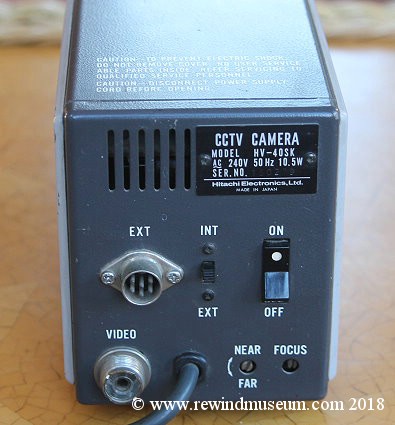
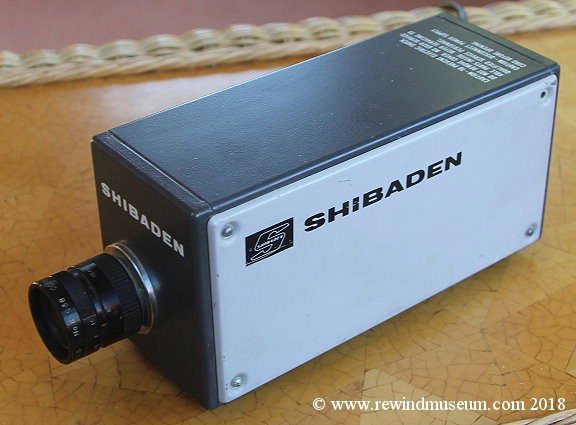
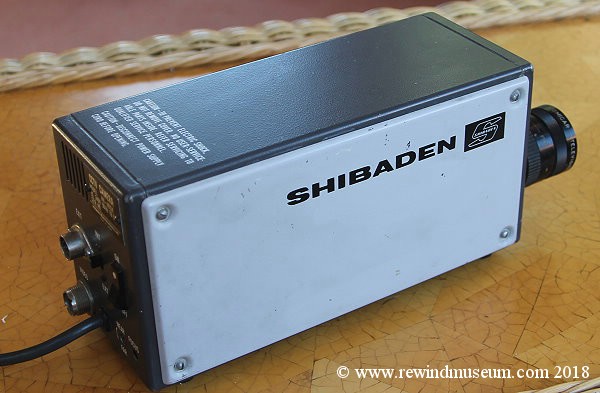
The Shibaden HV-50 came out in 1969 and this was an earlier camera. An estimated date of early to mid 1960s
would apply. This is a security camera. This Shibaden product was made by Hitachi Electronics. Made in Japan
1969. The Shibaden FP-707 camera
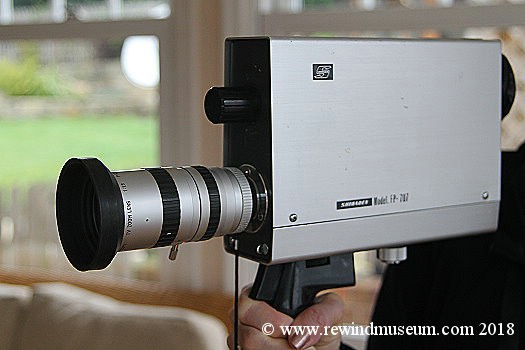
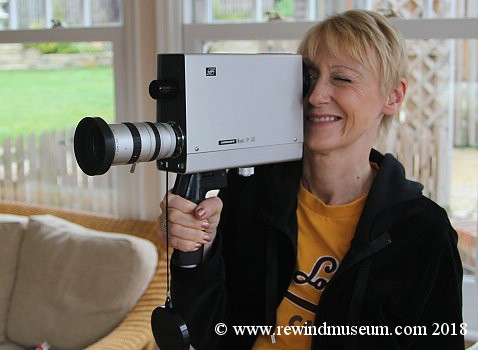
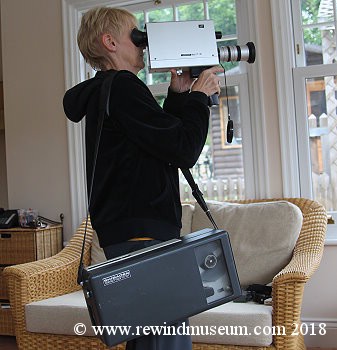
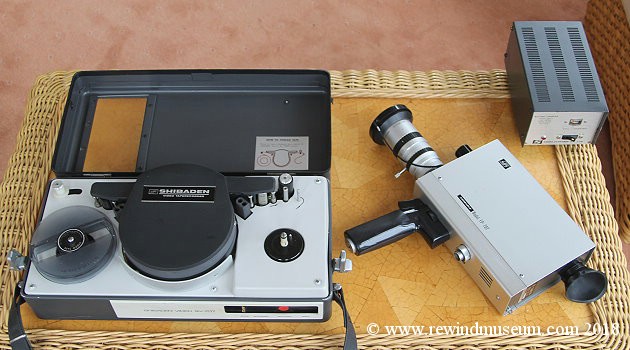
This is quite a rare camera. It uses a single Vidicon tube. It is designed to accompany the Shibaden
SV-707 record
only portable VTR. We also have the stand alone CU-707 camera power supply adapter and so the camera can be
used separately from the SV-707 VTR. This is a very well made piece of kit and although the vtr is heavy,
the camera is not and has a good lens. Also a very early piece of kit.
1969. The Akai VC-1A camera
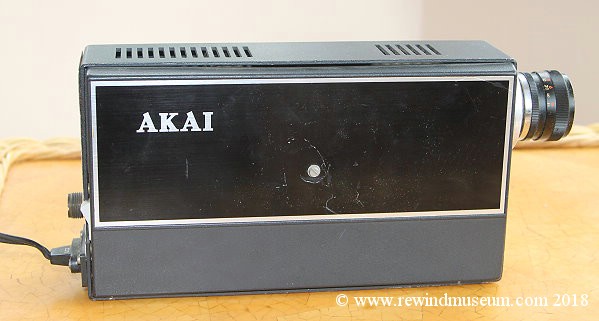
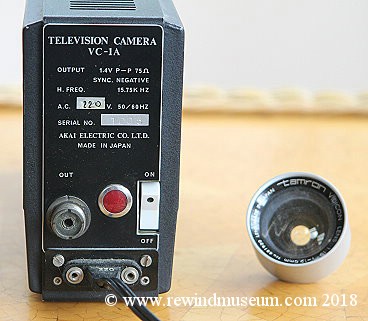
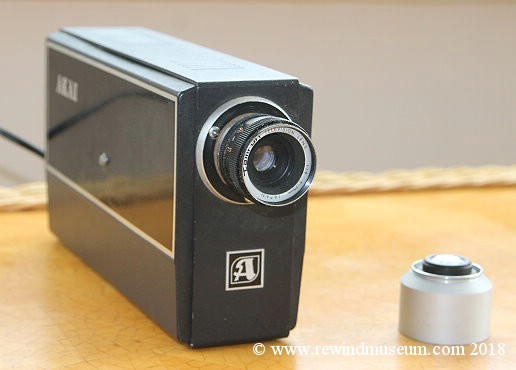
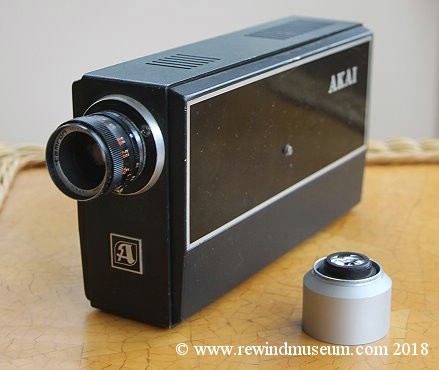
Here is a early simple black and white camera. It has a 1" vidicon tube, 50 mm, f 1.8 lens. Controls consist
of a mechanical focus and an on - off switch. It would probably have been used with an Akai X-500 reel to
reel video recorder from the same era.
1970. The Akai VC-100 camera.
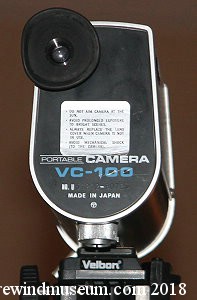
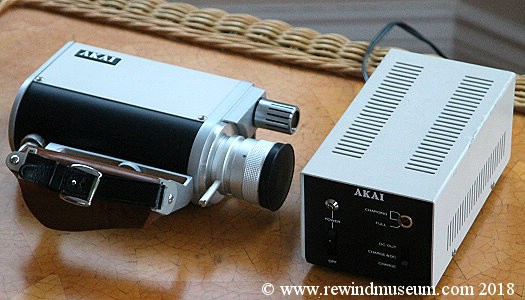
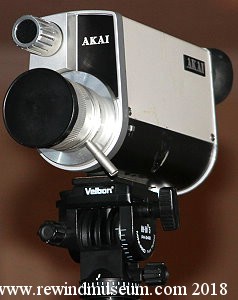
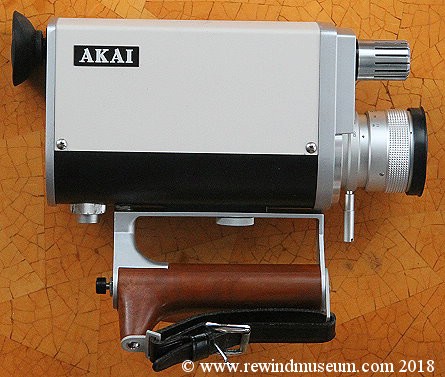
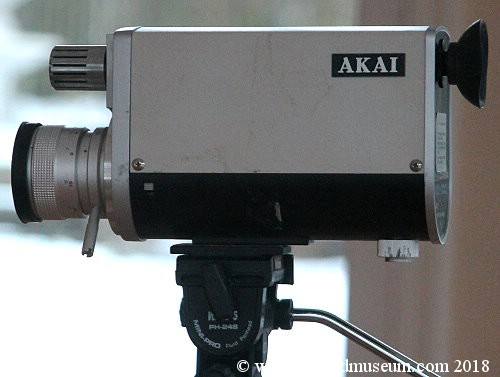
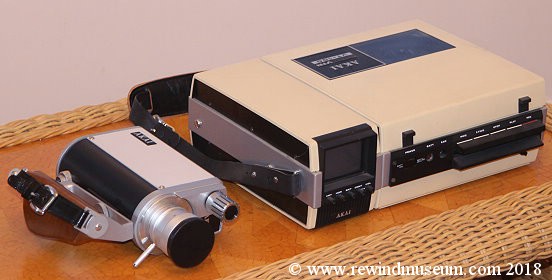
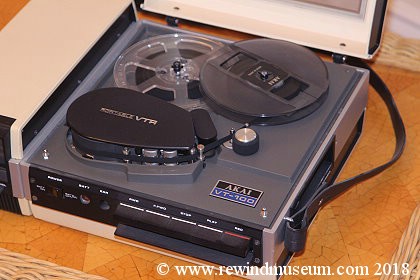
This camera is very small for 1970. It is a similar size to a modern camcorder but of course it is just a camera.
It is also much heavier due to the metal construction but light compared to other cameras available in 1970. It
was part of the
Akai VT-100 1.4-inch reel to reel VTR system. It is a black and white camera
with a
10-40mm/f1.8 zoom lens, a through the lens optical viewfinder and built in microphone.
1970. Sony AVC-3200 light studio camera with 4 inch viewfinder
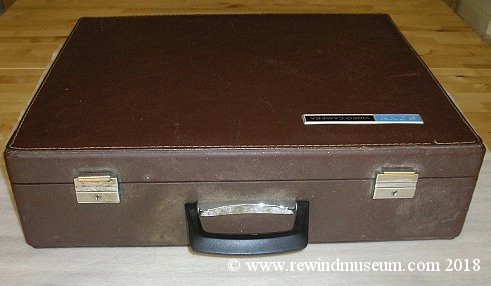
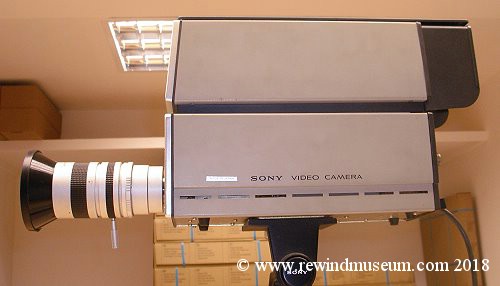
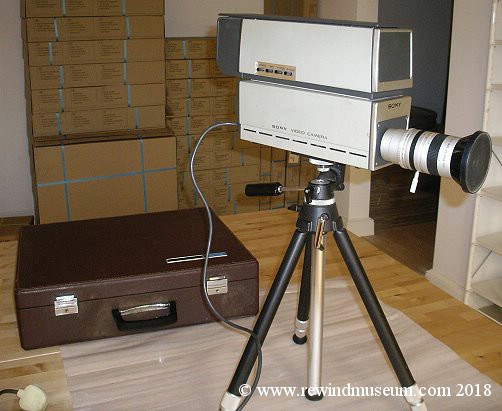
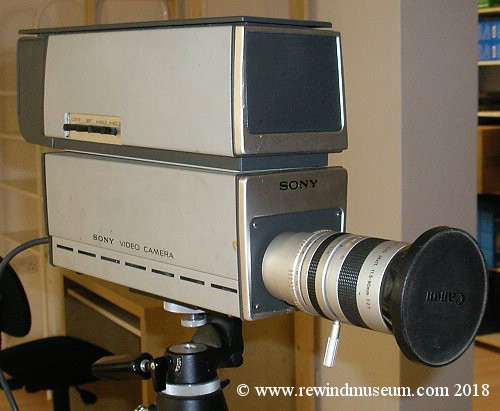
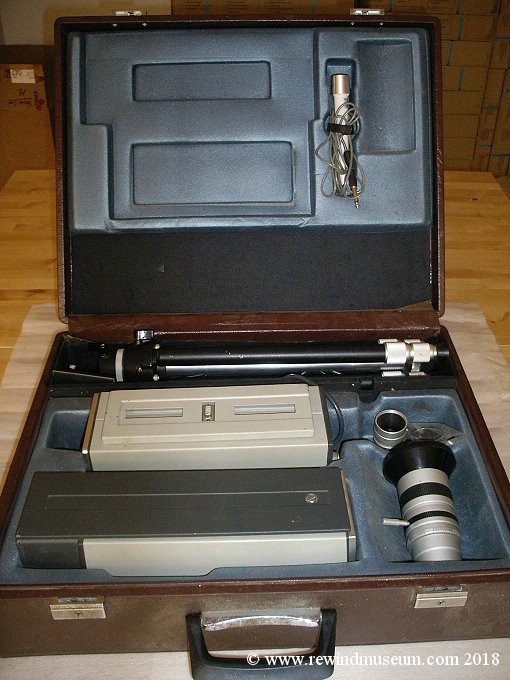
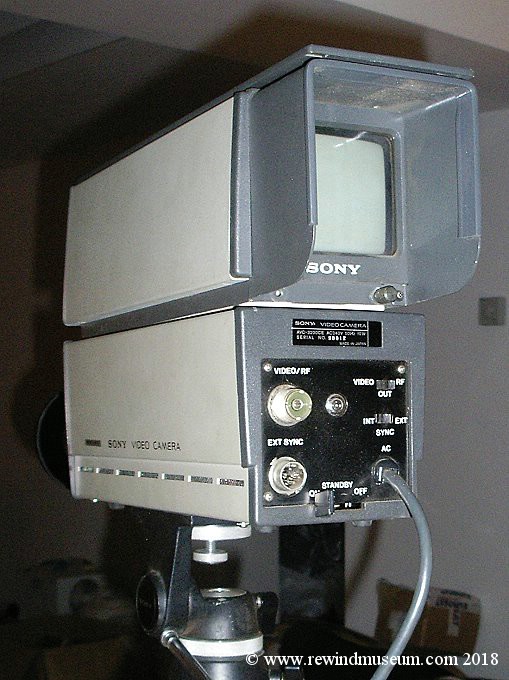
Complete camera kit including a Sony camera case, AVC-3200TE base, AVC-3200CE screen/monitor attachment,
TV zoom lens 11.5-90mm, Basic Sony TV lens 16mm, original Sony tripod, original Sony microphone and BNC
to TV lead. The AVC-3200 uses a 2/3" vidicon tube and has a detachable 4" viewfinder.
This is classed as a light studio camera with an excellent zoom lens and is for professional use.
1970. Sony AVC-3420CE camera
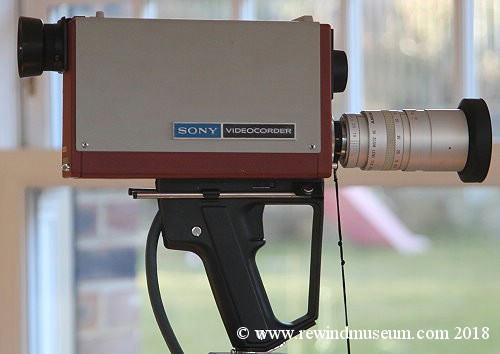
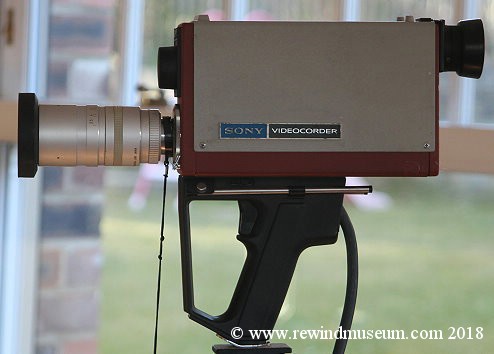
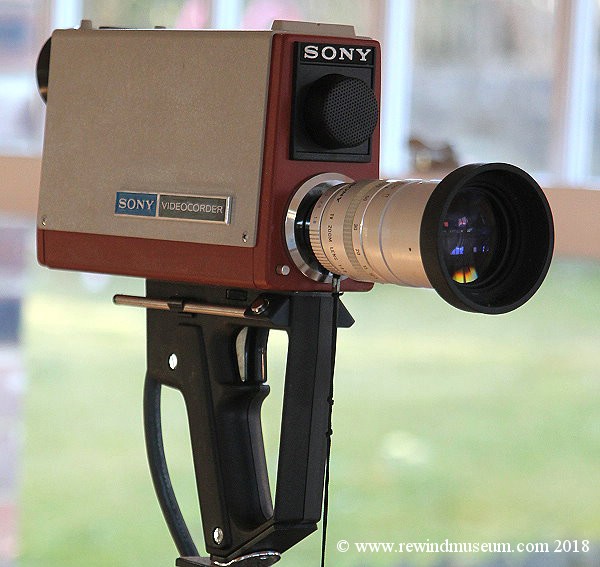
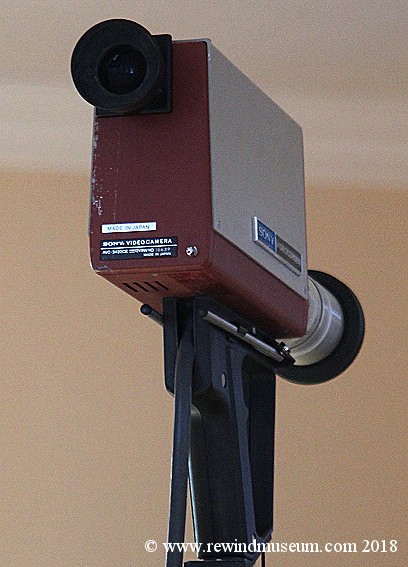
This is the camera which first accompanied the
Sony VC-3200 reel to reel portable video recorder (Rover II) in 1970.
This camera uses a 2/3 inch vidicon tube for a standard black and white video signal. A f-1.8, 6:1 (12.5mm to 75mm) zoom lens.
The viewfinder uses a magnifier lens.
1974. The Sony DXC-1600 camera
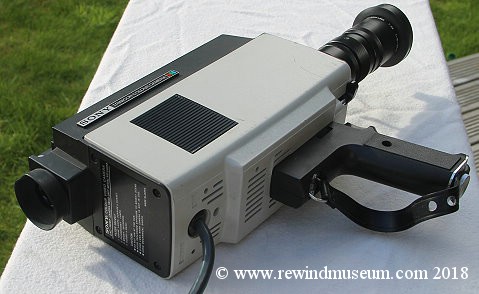
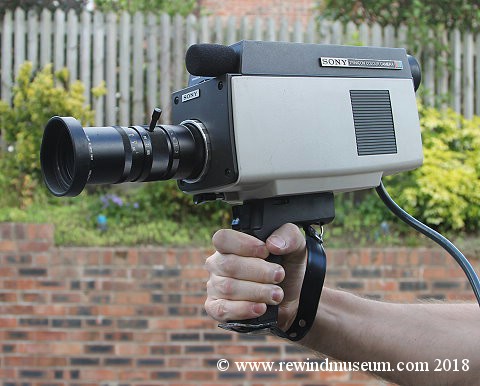
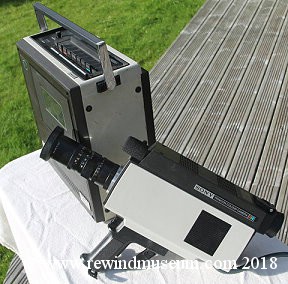
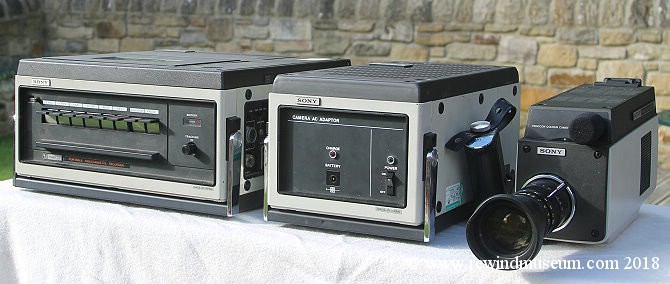
This camera was available to accompany the worlds first portable VCR, the
VO-3800
The DXC-1600 was a Trinicon tube hand held colour camera. Another first - This was also Sony's first production
hand held colour video camera. Is is a single tube hand held colour camera and the camera head contains
a 1.5 inch black and white CRT viewfinder
1974 Panasonic WV-3085 camera.
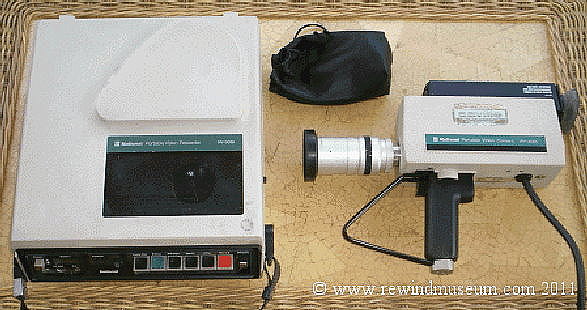
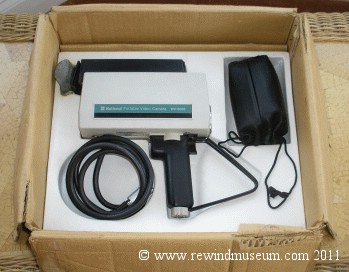
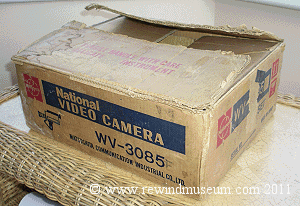
The camera is in it's original packaging. It is designed to go with the
Panasonic NV-3085 EIAJ portapack portable VTR.
This camera has a 2/3" vidicon tube, 1-1/2" viewfinder. The lens is a Fujinon 6:1 (12.5 - 75mm) zoom lens.
Must have been one of the last portable kits that used a VTR (reel to reel video) as video cassettes were
already being used by Philips in 1974 for domestic (not portable) use. The
first VHS portable cassette
system from JVC (Panasonic also used VHS) was not until 1978, 4 years later.

1974. JVC GC-4800U colour video camera with power supply
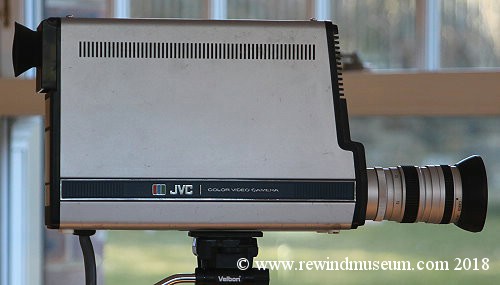
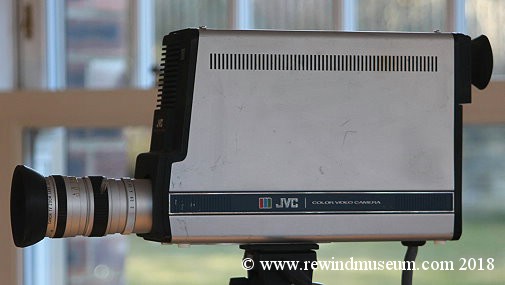
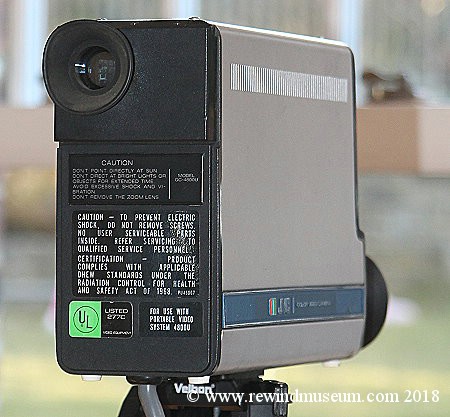
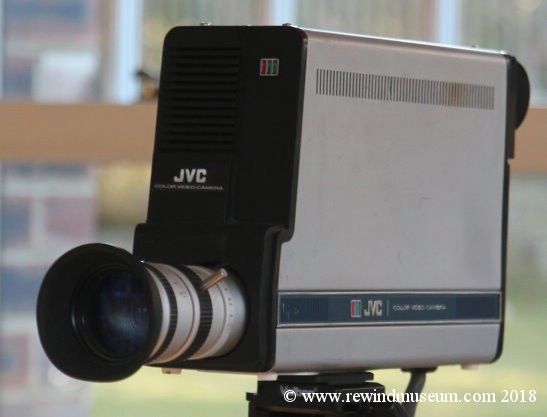
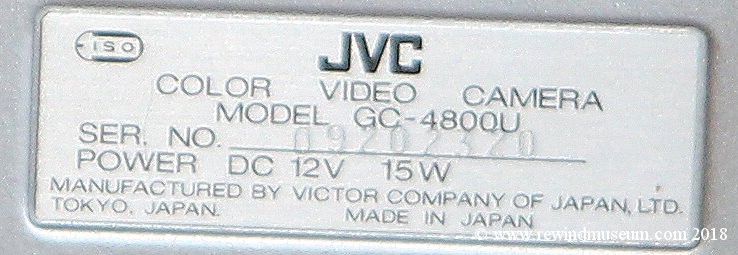
This is the colour camera which accompanied the JVC PV-4800U portable 1/2-inch tape colour VTR. This camera
uses two vidicon tubes. The GC-4800 contains a built in 1 and 1/2" viewfinder. Also included is the GA-20U
colour camera adapter. Other sites say this kit is from 1976, however, the correct date is 1974. It was
announced by JVC at "CES" (the Consumer Electronics Show) in 1974 and the show was featured in the 22nd
June 1974 issue of "Billboard" (music recording newspaper) who commented on this colour camera kit. This was
an advanced piece of colour recording kit for 1984. We also have the
PV-4800U portable VTR in the museum.
1978. The Sony AVC–3450CE camera
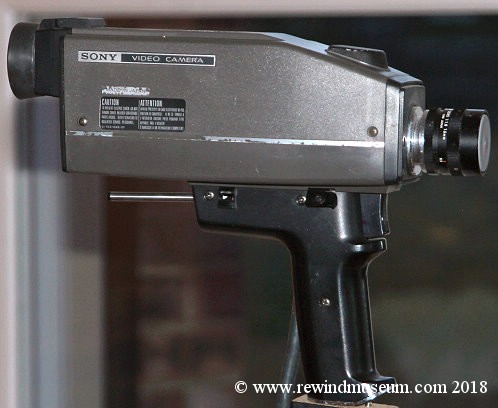
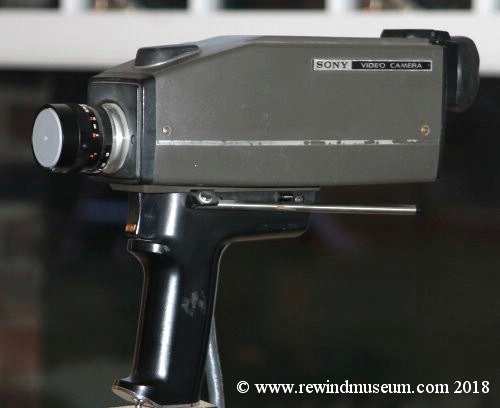
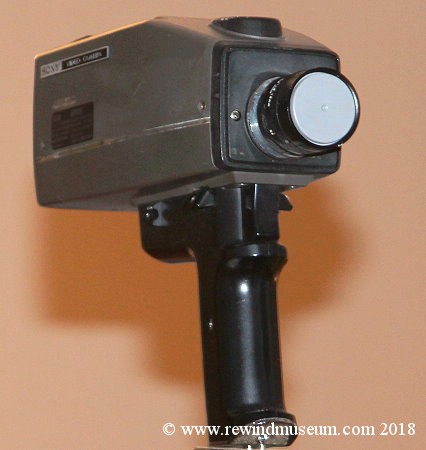
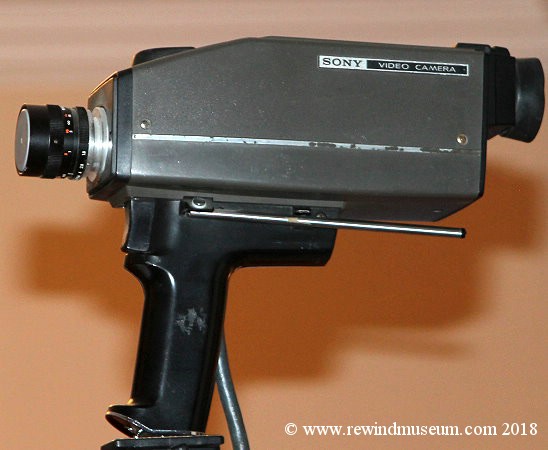
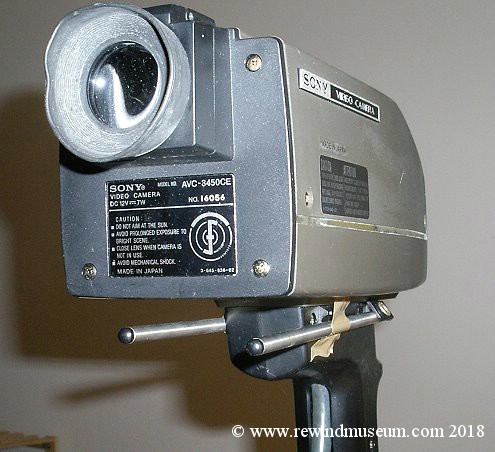
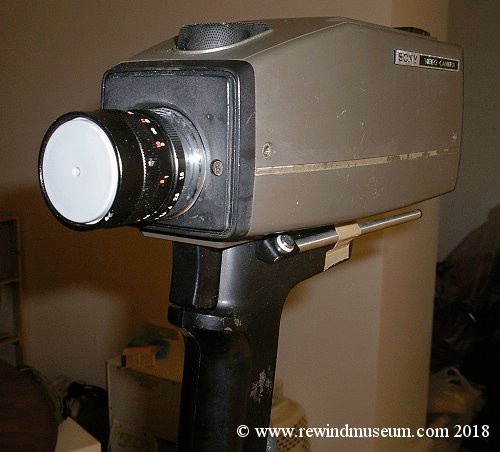
The Sony AVC-3450 Portapack camera was Sony's second Rover II camera and had a better vidicon tube compared
to the AVC-3400 camera. It was used with the portable
AVC3400 Rover VTR kit and the
Betamax SLO-340 kit.
1980. The Sony HVC 2000P
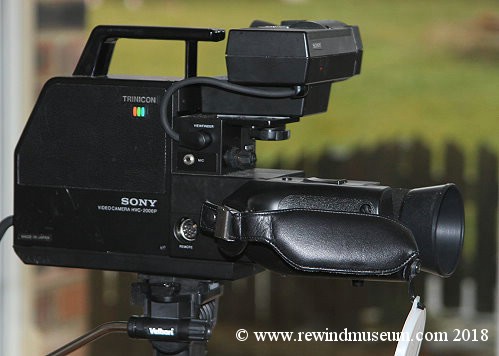
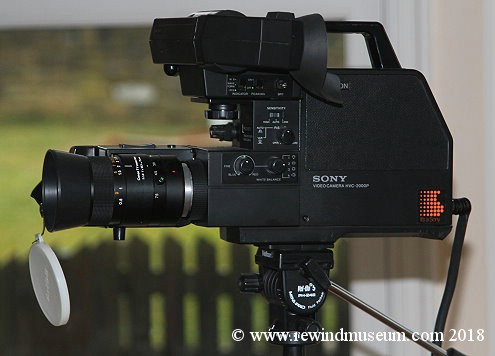
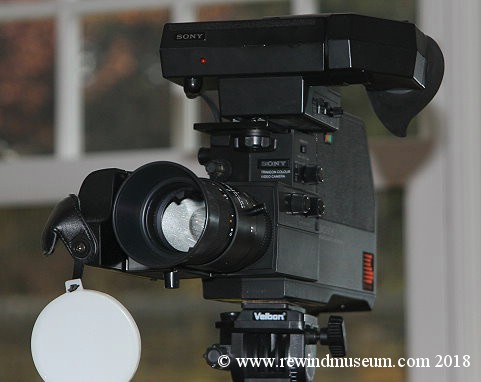
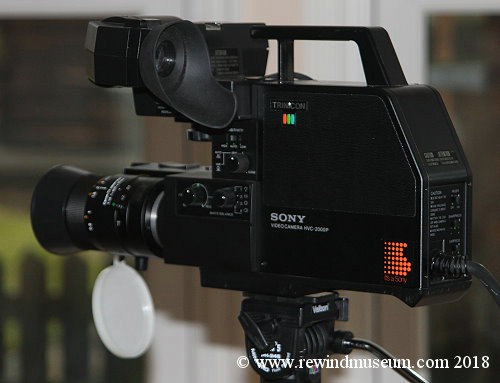
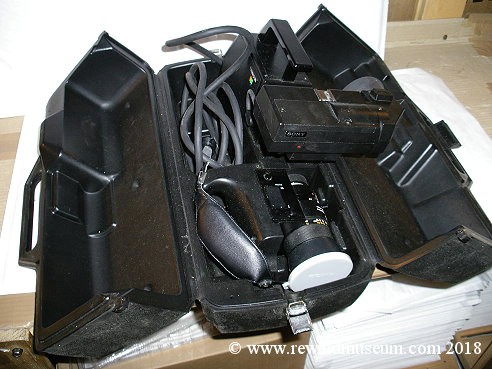
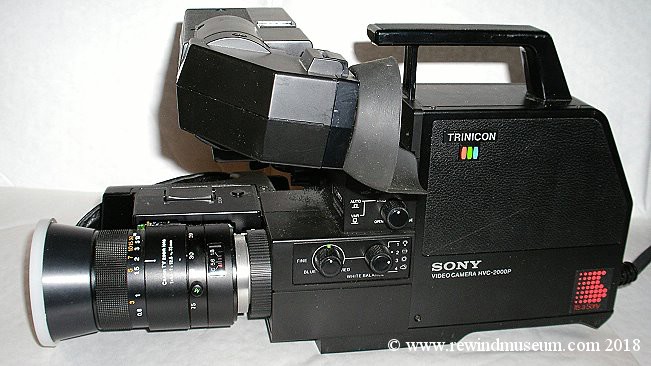
This camera has a single 2/3-inch MF Trinitron tube, 300 lines of resolution, fader, sharpness control, sensitivity
booster, remote operation. All complete in camera case. The viewfinder has to be screwed into the front of the camera
and this is time consuming compared to the usual folding method. In it's day it was a good camera, however, within 3
years Sony will introduce the world first camcorder, the
BMC100P.
We have two of these Sony HVC 2000P cameras in camera cases in the museum.
1981. Hitachi FP-10 colour light studio camera.
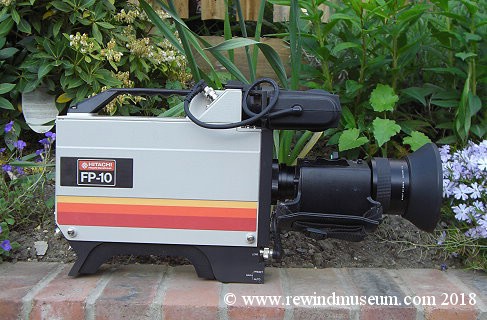
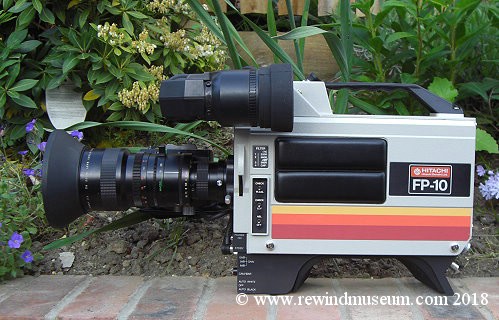
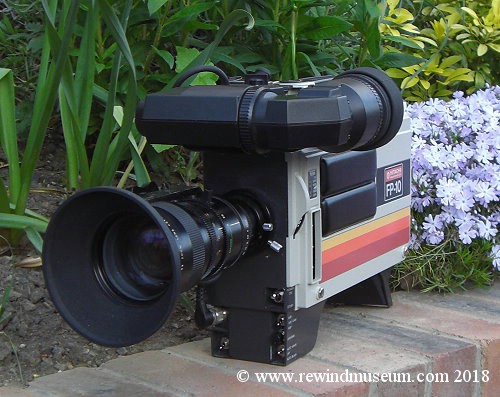
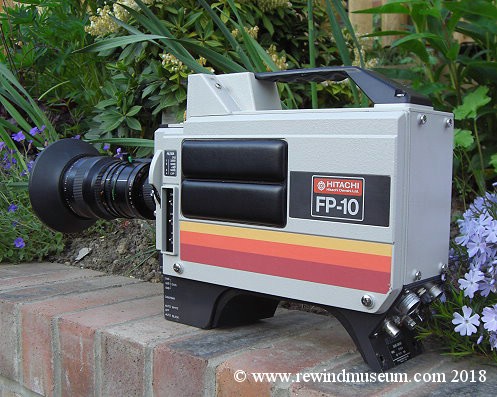
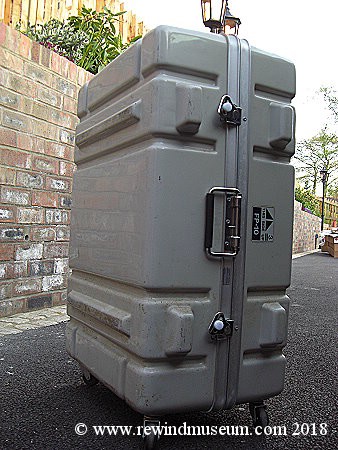
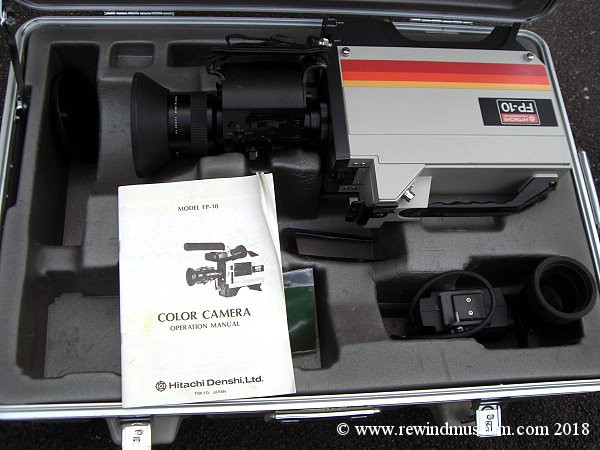
In December 1981 Hitachi introduced this 1 tube colour studio camera.
Horizontal resolution was 450 lines. This was very good at that time and as good as many 3 tube cameras.
The camera weighed 5.5Kg and so it was light enough to be shoulder mounted.
It used a 1-inch tri-electrode Saticon pick-up tube. It could be used as a studio camera with
an optional 5-inch viewfinder. The kit is complete with original carry case and manual.
1981. JVC G-71P colour camera.
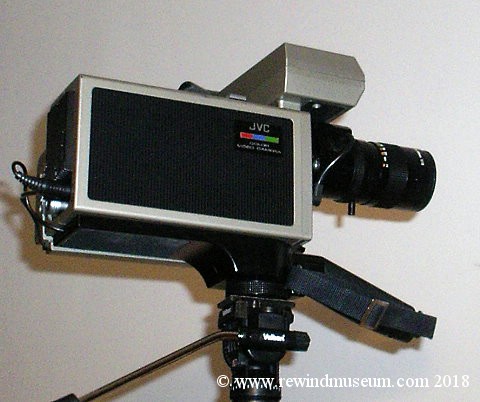
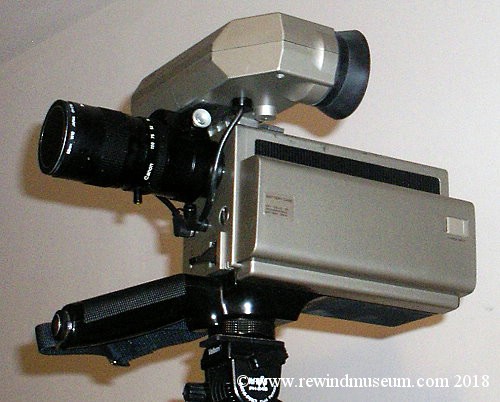
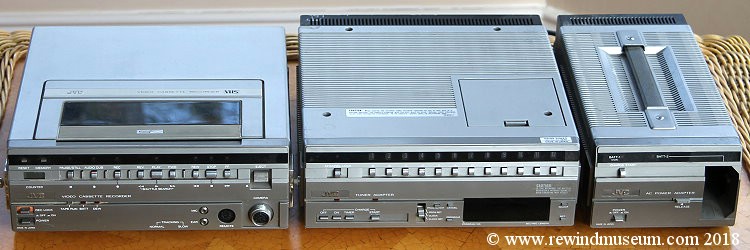
This colour camera was sometimes packaged with the
JVC-HR-2200 portable VCR. This camera is unusual as at this
time cameras would be powered by a camera power supply unit like the AA-P22EG/EK or from the portable VHS
unit. Here in the right hand picture above you can see a rechargeable battery pack on the side of the camera.
Rechargeable batteries attached or inside of camcorders were common but not usually attached to a camera.
1982. The JVC GX-78E colour camera
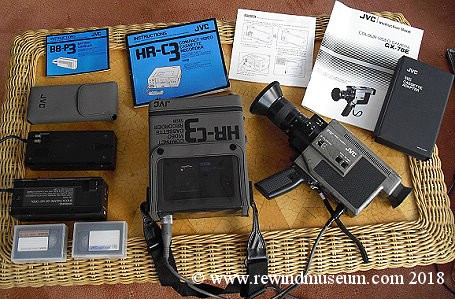
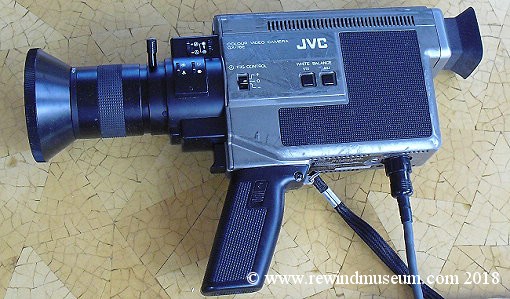
The first VHS portable above was quite heavy and that was because it used a full size VHS tape / tape mechanism.
JVC (Victor Company of Japan) invented the VHSC systems using a smaller tape in 1982. The smaller VHSC tape could
go into a VHS tape adapter and then play in a standard VHS VCR. The
HR-C3 VCR came with this GX-78E camera
1982. The JVC KY1900E camera
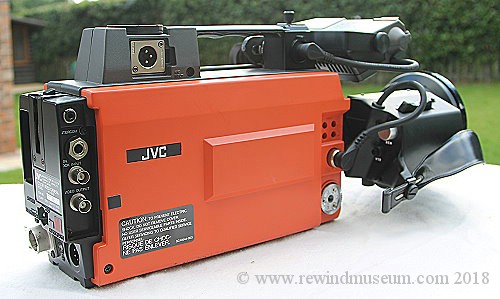
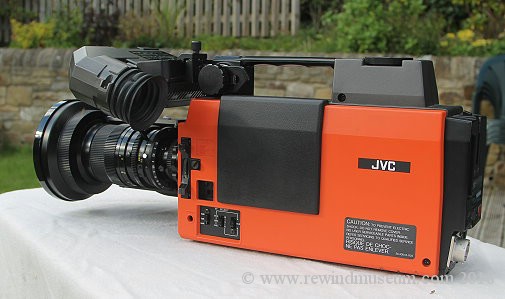
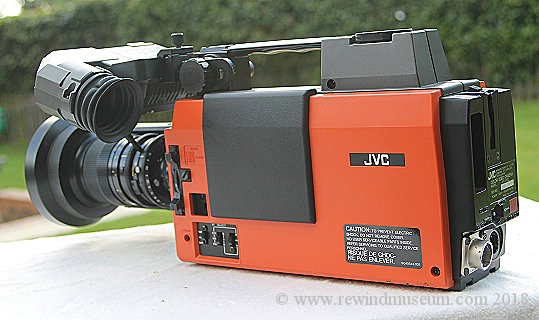
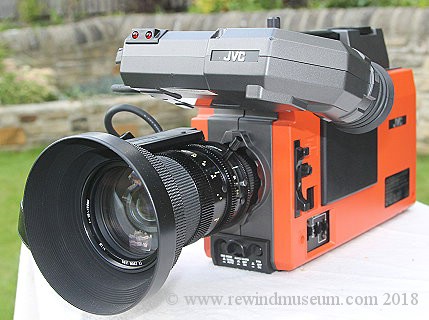
The KY-1900E had three saticon tubes which resolved around 400 lines of resolution, price £4700. This bright
colour camera was used by production companies to record corporate events. Like the JVC KY19 below it had
an excellent lens. A very good camera in it's day.

1988. The Panasonic F10 camera.
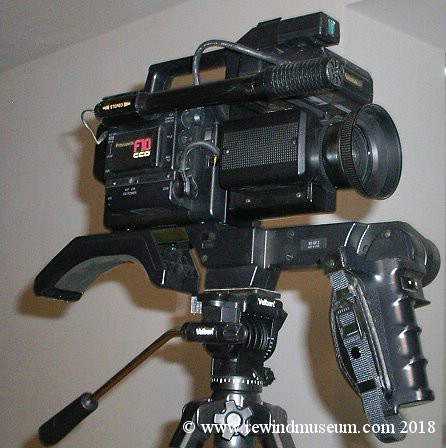
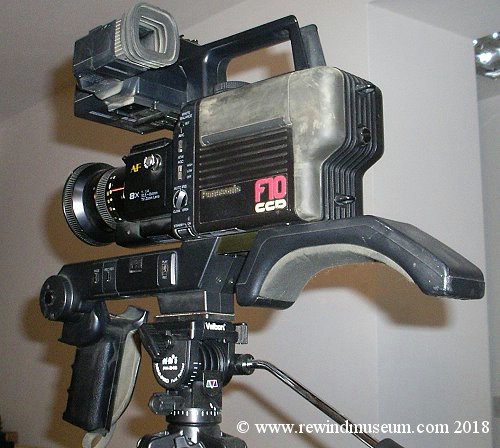
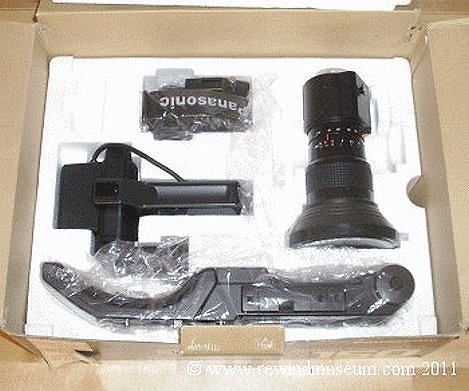
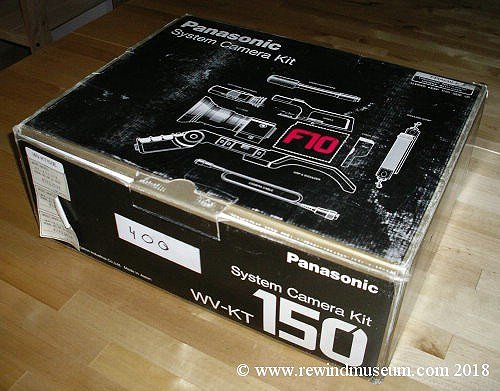
The Panasonic F10 camera was called a "component" camera as lots of accessories bolted on and off. It used
the VHS system and would be connected to a full size VHS tape shoulder strap portable video recorder. I had
been shooting video since 1980 but in 1989 I started a video business. This was just at the time SVHS
(higher resolution - 400 lines) started and so the first "camera" was an SVHS camcorder, however I saw many
other people at the time using this F10 camera and separate video recorder. This was one of the very first
cameras which used a CCD chip rather than a tube to capture the picture.
Panasonic replaced this camera in 1993 by the F15 SVHS version. See below.

1993. The Panasonic F15 camera.
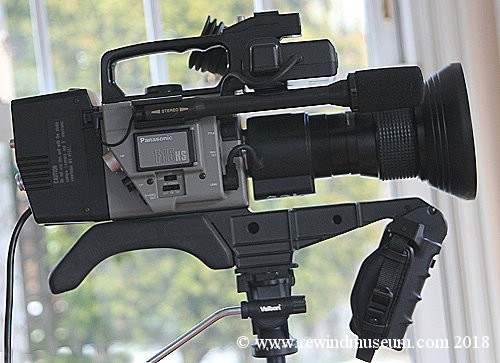
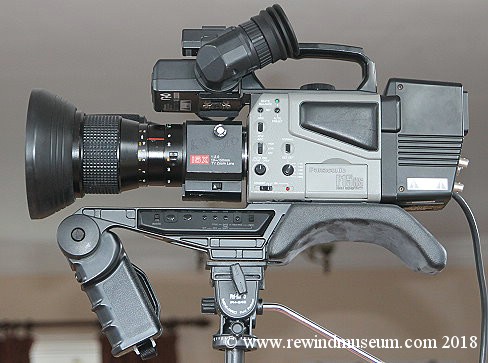
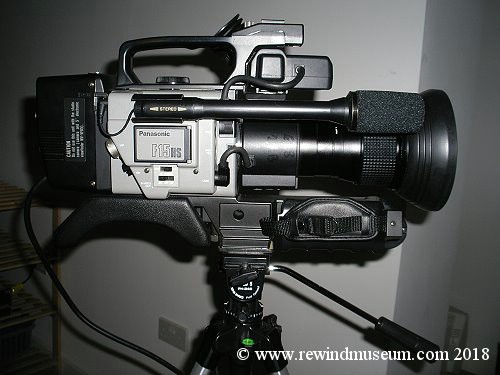
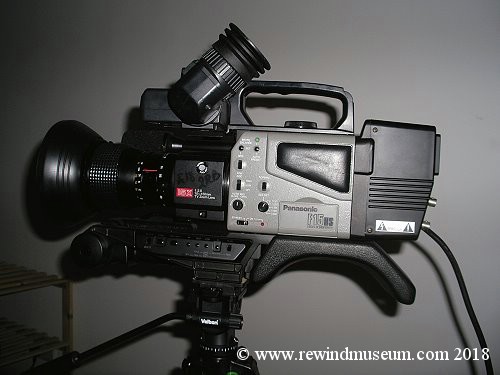
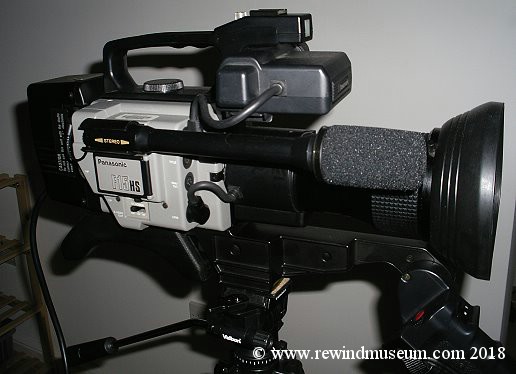
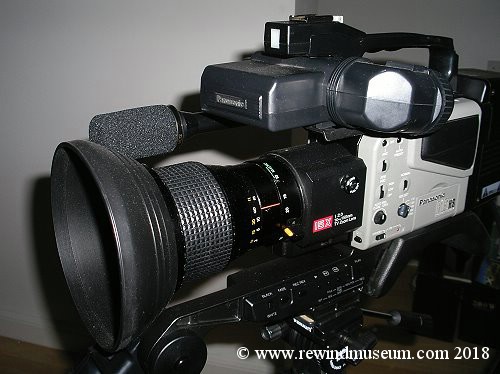
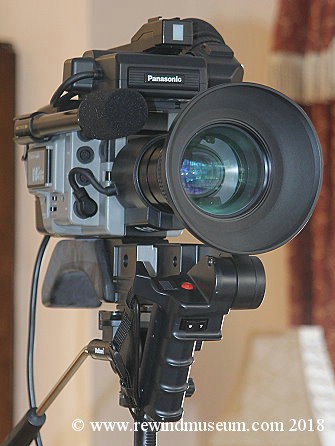
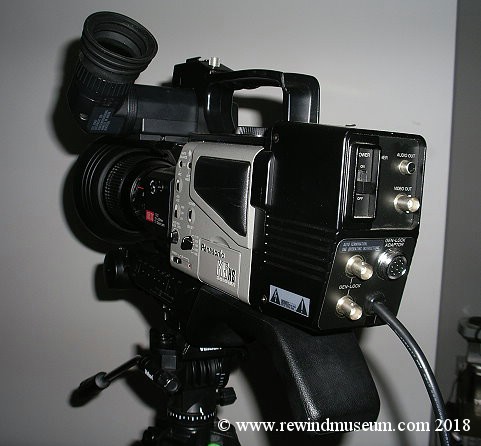
The Panasonic F15 camera, like the F10 above was also called a "component" camera as lots of accessories
bolted on and off. It used the SVHS system and would be connected to a full size or compact SVHS tape
shoulder strap portable video recorder. When this camera came out I really wanted one. At the time I was
using an SVHS camcorder but this camera with a good portable vcr was capable of amazing pictures. The 10X
optical zoom lens of the F10 had been replaced with a 15X optical zoom lens. When this camera finally came
into the museum I was excited and eager to compare the picture quality with a modern digital camcorder.
It fell a long was short and so was disappointing. TV had moved on.

1993/94. The JVC KY19 dockable camera and
BR9422L dockable recorder.
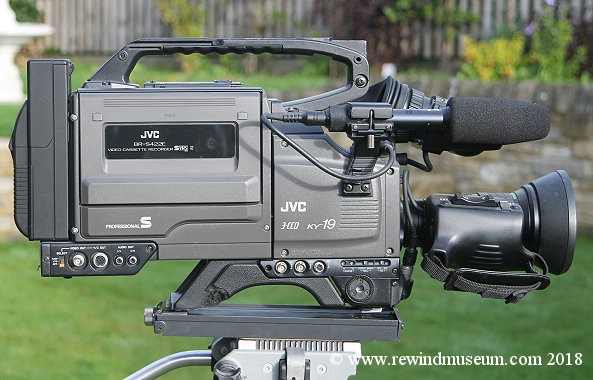
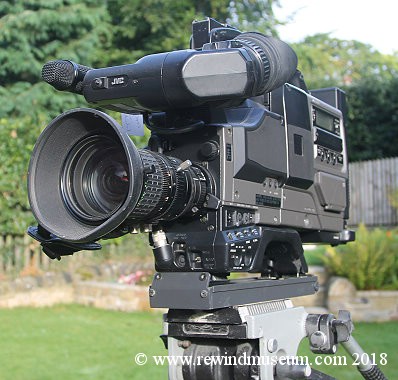
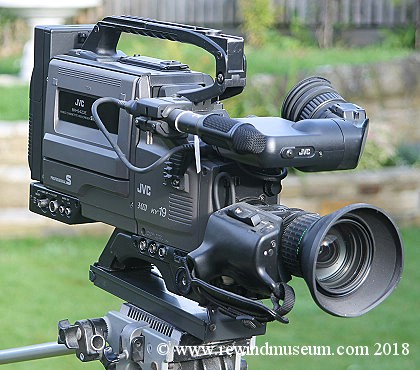
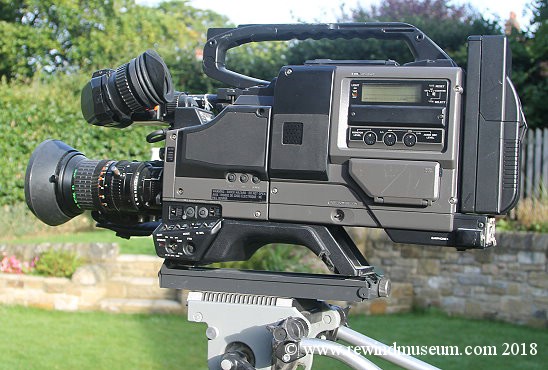
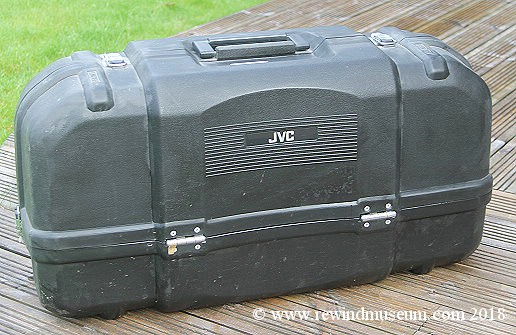
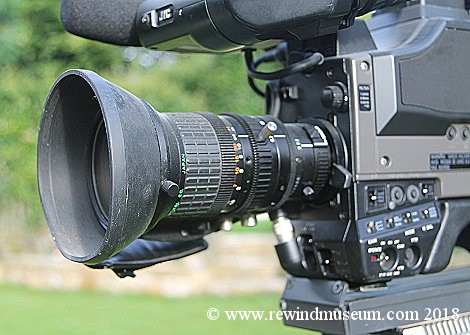
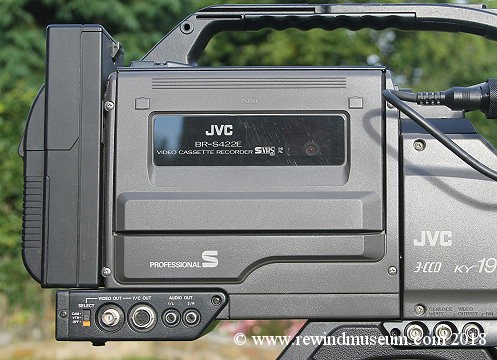
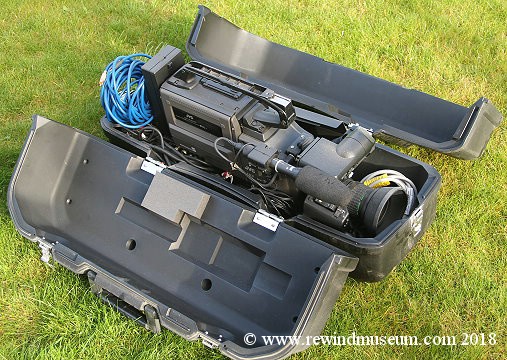
There is a press release about JVC introducing this camera in March 1994, however, parts for their "popular KY 19" camera also
came out in March 94 and it would seem logical it had must have been available a bit longer if it was already popular. Also
the docking S-VHS recorder B-S944E came out in 1993 although this could have docked with other cameras. This was the kit
I always wanted when I was in the video production business but I could not afford it. Eventually I was able to buy this one
second hand. Maybe 1996. As you can see the whole kit came in fantastic condition and this was a fantastic camera. It was
used to film large productions in Theatres. The Fujinon lens, 750 lines of camera resolution, 1/2-inch 3 x CCDs and low light
capability made it the perfect source before the recording stage. From the JVC (archived) web site it says "The KY-19U is top
of its class. New 380,000 pixel, 3CCD, 1/2-inch CCDs, deliver 750 lines of horizontal resolution. High sensitivity
(F/8.0, 2,000 lux) and an S/N ratio of 62dB mean crisp, clear pictures even when the light fades. MSRP: $7,845.00"
Also see the BR-S422U S-VHS dockable recorder MSRP: $3,919.00. With the case and all of the other accessories, the
original price would have been over $12000. This was a heavy kit and so using it was best done on a tripod.

BBC Cameras
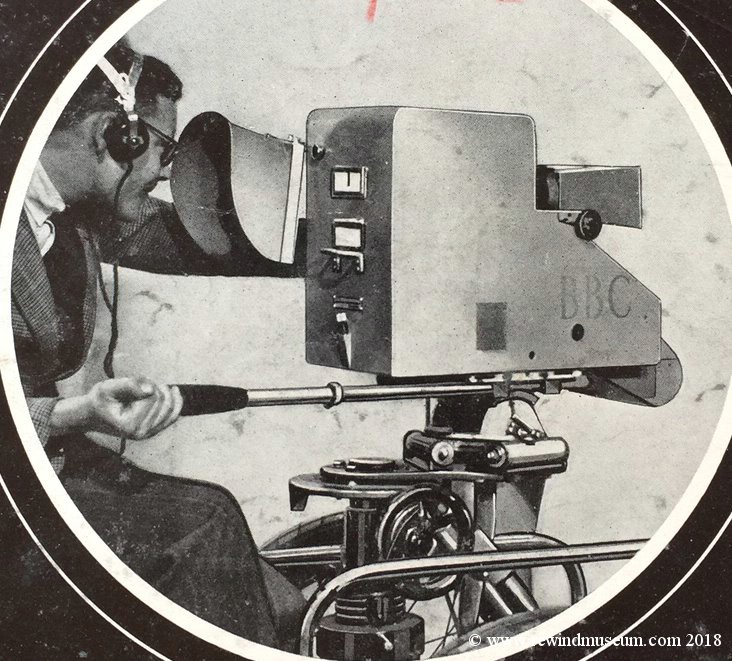
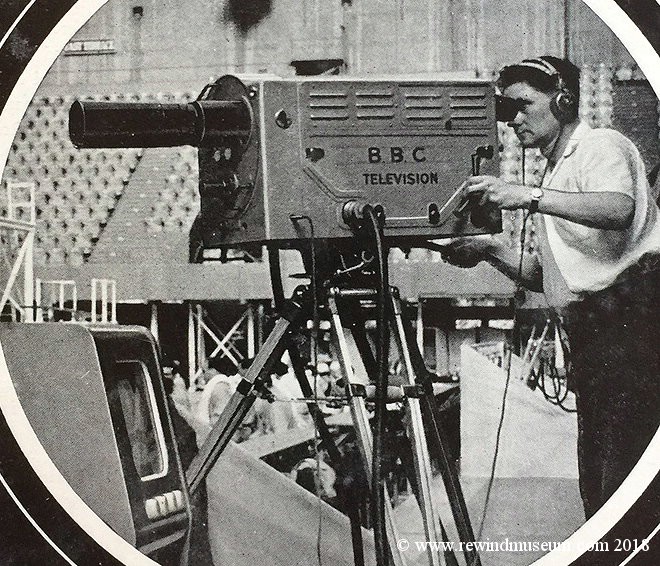
Top picture from the front cover of Wireless World July 1946.
Bottom picture from the front cover of Wireless World September 1948.
 Making a donation.
Making a donation.
The Rewind Museum is a non-profit making endeavour. The web site and the touring exhibitions are run on
a voluntary basis. Donations,
not money, just old items you no longer want, are always welcome.
If you have something that you think would be of interest, please contact us with the details.
We can send in a courier to pick them up. (Even an international courier). Thank you.
Please note - The Rewind Museum site has been archived by the British
Library so that future generations can always access the site's content.
To talk to us about making a donation please go to - "
making a donation".
Are you interested to read about a 10 year + restoration of a classic vehicle?
If so go to -
www.1952chevytruck.com
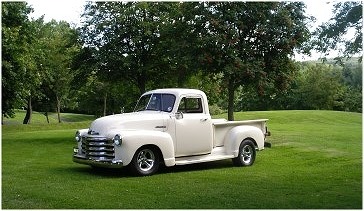 The 1952 The 1952 Chevy truck web site.
The 1952 The 1952 Chevy truck web site.

Web site copyright © 2018 Vision International. All rights reserved.
For all questions & comments about this site's content contact Dave at Rewind Museum.
